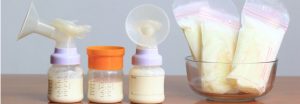
When it comes to breastfeeding, many moms worry about having a low supply or a drop in their supply. Another issue that could arise is that of having an oversupply. This can be hard to determine, especially for new moms.
These issues may bring up many questions, especially when it comes to expressing milk, wet nurses, formula transitions, and even natural options to help increase low breastmilk supply. We have put together an in-depth guide to help understand milk supply issues while breastfeeding.
How Supply Works
Once you have had your baby and your breast milk comes in, your breasts will produce your milk with a “supply and demand” routine. Whether you are breastfeeding, pumping, or hand expressing, when breast milk is removed your breasts will make more.
What Can Affect Supply
If you are a mother that needs to substitute or combine with formula it is important to know that this can reduce your milk supply. This is because your body is not getting the message to produce more milk. If there is no demand, then your supply will decrease.
Another way that your supply can be affected is the way that your baby nurses. When your baby feeds more often and effectively than you will produce more milk.
Medical reasons can cause a low milk supply. If you experienced excessive blood loss during birth, have a history of polycystic ovarian syndrome, diabetes, thyroid, or other hormonal disorders, improper nutrition, anemia, have mammary hypoplasia, or even have had previous breast surgeries or breast trauma then your milk supply may be affected. If you find that you fit into one of these categories, it may be in your best interest to seek out a lactation consultant or breastfeeding specialist.
Things to Consider When Determining Supply
While you are trying to determine if your supply is enough or too much for your baby consider the following questions:
- Is your baby latching correctly? The most common reason for a low milk supply is that your baby has a poor latch. If your baby does not latch on to the breast correctly, than they cannot get the milk out of your breasts properly. When the milk is removed from your breasts this triggers your body to produce more breastmilk. Therefore if your boobs are not being emptied properly your supply will drop. You can check your baby’s latch using videos online, a nurse, your doctor, or a lactation consultant.
- One common issue women have with a bad latch is that of flat or inverted nipples. If this is the case, there are easy solutions that can help to correct this quickly. One option is to use a product called supple cups or a nipple shield.
- Are you breastfeeding enough? If you are not feeding your baby enough throughout the day this is another reason for a drop in supply. Newborns need to nurse at least every two- three hours daily. This means that you will need to wake them up throughout the night to feed and keep your supply up. The more often that you feed your baby, the more milk that your body will produce.
- If your baby is nursing it is best practice to feed your baby on demand. This will help to ensure that you build a strong and healthy milk supply.
- Is your baby eating long enough ? When you nurse your newborn they should eat for at least 10 minutes on each side. If your baby is breastfeeding for less than that they may not be getting enough milk to grow. If this is the case, they are also not removing enough milk to help maintain your supply.
- Is your baby gaining weight? It is normal for newborns to lose about 5 %- 7 % of their birth weight within the first few days. After the first few days, they should be gaining at least .7 to 1 oz per day. Babies should be back to their birth weight by two weeks old.
- How many wet and dirty diapers do they make? Watching your baby’s diapers is the best way for you to determine if they are receiving enough milk. If you have noticed a decrease in wet or dirty diapers this may be a cause of concern.
How to Express Milk
 One way to help with improving supply and to release pressure if you are experiencing an over supply is that of expressing your breastmilk. This can be done by massaging your breasts with your hands or by using a breast pump.
One way to help with improving supply and to release pressure if you are experiencing an over supply is that of expressing your breastmilk. This can be done by massaging your breasts with your hands or by using a breast pump.
If you are hand expressing the press- compress- release method can be very helpful and easy to learn. An easy way to hand express is as follows:
- Massage your breasts.
- While expressing, use your fingers and thumb to compress your breast for a few seconds. Release and repeat. Use compressions on both breasts until your milk flow slows to a trickle.
- Massage your breasts again.
- Switch between breasts to drain them as fully as possible.
Reasons to Express Milk
Many women chose to put their baby to breast and have that be it, as your baby is the best breast pump you could have. But this is not always possible for everyone, as you may have to return to work, wish to go out for a few hours, or just want the extra help throughout the day.
- Your baby has difficulty latching and expressing milk.
- You must return to work, but want to continue breastfeeding.
- You need to relieve tension and pressure from the breasts while at work to avoid leaking.
- Your breasts are too full and overextended for your baby to latch correctly. Expressing a small amount can help to latch correctly.
- Milk supply is starting to drop and you need to express more milk to improve production.
- You may have mastitis and need to clear the blockage to maintain milk flow.
Wet Nurse
While this is not very common in the U.S. an option that women could take when having a low supply is that of hiring a wet nurse. A wet nurse is a woman who has a healthy breastmilk supply with their own child, and also either nurses your child or provides breastmilk to help feed your child.
Likewise, wet nursing can also be done to help improve your own supply. If your baby struggles with latching or is premature, you can improve your own milk supply by nursing a healthy baby.
Formula Transition/ Supplementation
If you are choosing to supplement with formula or transition to formula you will notice a change within your supply.
If you are supplementing formula, but wish to maintain your supply or raise a low supply it is important to express your milk throughout the day or every time you feed your baby formula. When you are seeking to improve or maintain your supply it is vital to remove the milk from your breasts in order to produce more.
If you are transitioning from breastfeeding to formula you will probably notice an oversupply throughout the transition. You will want to still express milk during the transition and weaning process to help prevent mastitis. However, you can begin to express less often. Slowly take out a “feeding” or expression to decrease your supply until you have transitioned fully to formula.
Natural Ways to Help Improve Breastmilk Supply
 If you are experiencing a drop in supply, there are a few natural ways to help improve your supply:
If you are experiencing a drop in supply, there are a few natural ways to help improve your supply:
- Skin to Skin. By having skin-to-skin contact with your baby before and during feeding you can help to stimulate your body’s oxytocin hormone. This will help to get your milk flowing.
- Relaxation techniques can also help to improve your supply. You can try listening to your favorite music or enjoying an activity that helps reduce your anxiety.
- Using a breast pump. Double pumping can help you to produce more milk in less time. This will also help you to remove more milk from your breasts fully. Pumping or expressing milk right after a feed can also help to increase your milk supply. This might not produce much milk at first, but with time you will notice an increase in your supply. Adding a pump session at night when your prolactin levels are at the highest is also a good idea. You should notice an increase in about two- three days of regular pumping.
Keep In Mind
Once your baby is gaining weight and you’ve increased your supply, then you return to feeding exclusively at the breast.
However, if you notice that your supply has not increased after attempting to boost it on your own, you should consider contacting a lactation consultant or breastfeeding specialist.


